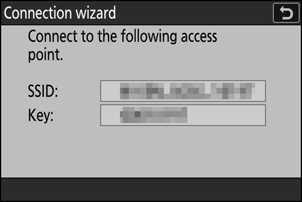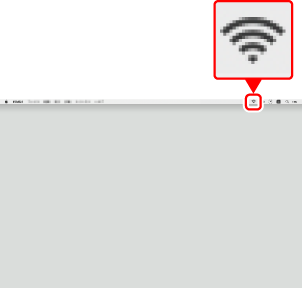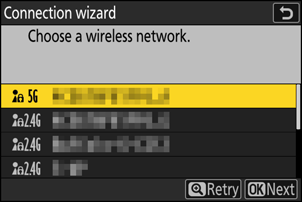Computers: Connecting via Wireless LAN
The camera can connect to computers via Wi-Fi (built-in wireless LAN).
Connecting to Multiple Devices
The camera can connect to only one type of device (computer, FTP server, or smart device) at a time. End the current connection before attempting to connect to a device of a different type.
If you have trouble connecting, try:
- turning the camera off and then on again,
- checking wireless settings on the computer, or
- restarting the computer.
For information on wireless- or Ethernet-related errors, see “Troubleshooting Wireless LAN and Ethernet Connections” (0Troubleshooting Wireless LAN and Ethernet Connections).
The Wireless Transmitter Utility
Before you will be able to connect to a wireless LAN, you will need to pair the camera with the computer using Nikon’s Wireless Transmitter Utility software.
- Once the devices are paired, you will be able to connect to the computer from the camera.
The Wireless Transmitter Utility is available for download from the Nikon Download Center. Check the version and system requirements and be sure to download the latest version.
Connecting to Computers via Wireless LAN
The camera can connect to computers either by direct wireless link (access-point mode) or via a wireless router on an existing network, including home networks (infrastructure mode).
Direct Wireless Connection (Access-Point Mode)
The camera and computer connect via direct wireless link. The camera acts as a wireless LAN access point, letting you connect when working outdoors and in other situations in which the computer is not already connected to a wireless network and eliminating the need for complicated adjustments to settings. The computer cannot connect to the Internet while connected to the camera.
- Before proceeding, check that the Wireless Transmitter Utility (0 The Wireless Transmitter Utility) is installed on the computer.

Select [Connect to computer] in the network menu, then highlight [Network settings] and press 2.

Highlight [Create profile] and press J.

Name the new profile.
- To proceed to the next step without changing the default name, press X.
- Whatever name you choose will appear in the network menu [Connect to computer] > [Network settings] list.
- To rename the profile, press J. For information on text entry, see “Text Entry” (0 Text Entry). Press X to proceed after entering a name.

Highlight [Direct connection to computer] and press J.

The camera SSID and encryption key will be displayed.

Establish a connection to the camera.
Windows:
- Click the wireless LAN icon in the taskbar.
- Select the SSID displayed by the camera in Step 4.
- When prompted to enter the network security key, enter the encryption key displayed by the camera in Step 4. The computer will initiate a connection to the camera.

macOS:
- Click the wireless LAN icon in the menu bar.
- Select the SSID displayed by the camera in Step 4.
- When prompted to enter the network security key, enter the encryption key displayed by the camera in Step 4. The computer will initiate a connection to the camera.

Start pairing.
When prompted, launch the Wireless Transmitter Utility on the computer.

Select the camera in the Wireless Transmitter Utility.
Select the name displayed by the camera in Step 6 and click [Next].

In the Wireless Transmitter Utility, enter the authentication code displayed by the camera.
- The camera will display an authentication code.

- Enter the authentication code in the dialog displayed by the Wireless Transmitter Utility and click [Next].

Complete the pairing process.
- When the camera displays a message stating that pairing is complete, press J.

- In the Wireless Transmitter Utility, click [Next]; you will be prompted to choose a destination folder. For more information, see online help for the Wireless Transmitter Utility.

- A wireless connection will be established between the camera and computer when pairing is complete.
Check the connection.
When a connection is established, the profile name will be displayed in green in the camera [Connect to computer] menu.
- If the profile name is not displayed in green, connect to the camera via the wireless network list on your computer.

A wireless connection has now been established between the camera and the computer.
Pictures taken with the camera can be uploaded to the computer as described under “Uploading Pictures” (0 Uploading Pictures) in the chapter titled “What You Can Do When the Camera Is Connected to a Computer or FTP Server”.
For information on controlling the camera from a computer using Camera Control Pro 2 or NX Tether, see the section on “Camera Control” (0 Camera Control) in the chapter titled “What You Can Do When the Camera Is Connected to a Computer or FTP Server”.
Connecting in Infrastructure Mode
The camera connects to a computer on an existing network (including home networks) via a wireless router. The computer can still connect to the Internet while connected to the camera.
- Before proceeding, check that the Wireless Transmitter Utility (0 The Wireless Transmitter Utility) is installed on the computer.

Connection to computers beyond the local area network is not supported. You can connect only to computers on the same network.
Select [Connect to computer] in the network menu, then highlight [Network settings] and press 2.

Highlight [Create profile] and press J.

Name the new profile.
- To proceed to the next step without changing the default name, press X.
- Whatever name you choose will appear in the network menu [Connect to computer] > [Network settings] list.
- To rename the profile, press J. For information on text entry, see “Text Entry” (0 Text Entry). Press X to proceed after entering a name.

Highlight [Search for Wi-Fi network] and press J.
The camera will search for networks currently active in the vicinity and list them by name (SSID).

To connect without entering an SSID or encryption key, press X in Step 4. Next, highlight one of the following options and press J. After connecting, proceed to Step 7.

Option Description [Push-button WPS] For routers that support push-button WPS. Press the WPS button on the router and then press the camera J button to connect. [PIN-entry WPS] The camera will display a PIN. Using a computer, enter the PIN on the router. For more information, see the documentation provided with the router. Choose a network.
- Highlight a network SSID and press J.
- The band on which each SSID operates is indicated by an icon.
- Encrypted networks are indicated by a h icon. If the selected network is encrypted (h), you will be prompted to enter the encryption key. If the network is not encrypted, proceed to Step 7.
- If the desired network is not displayed, press X to search again.

Hidden SSIDs
Networks with hidden SSIDs are indicated by blank entries in the network list.
- To connect to a network with a hidden SSID, highlight a blank entry and press J. Next, press J; the camera will prompt you to provide an SSID.
- Enter the network name and press X. Press X again; the camera will now prompt you to enter the encryption key.

Enter the encryption key.
- Press J and enter the encryption key for the wireless router.

- For more information, see the documentation for the wireless router.
- Press X when entry is complete.

- Press X again to initiate the connection. A message will be displayed for a few seconds when the connection is established.

Obtain or select an IP address.
Highlight one of the following options and press J.

Option Description [Obtain automatically] Select this option if the network is configured to supply the IP address automatically. A “configuration complete” message will be displayed once an IP address has been assigned. [Enter manually] Enter the IP address and sub-net mask manually.
- Press J; you will be prompted to enter the IP address.
- Rotate the main command dial to highlight segments.
- Press 4 or 2 to change the highlighted segment and press J to save changes.
- Next, press X; a “configuration complete” message will be displayed. Press X again to display the sub-net mask.
- Press 1 or 3 to edit the sub-net mask and press J; a “configuration complete” message will be displayed.
Press J to proceed when the “configuration complete” message is displayed.
Start pairing.
When prompted, launch the Wireless Transmitter Utility on the computer.

Select the camera in the Wireless Transmitter Utility.
Select the name displayed by the camera in Step 9 and click [Next].

In the Wireless Transmitter Utility, enter the authentication code displayed by the camera.
- The camera will display an authentication code.

- Enter the authentication code in the dialog displayed by the Wireless Transmitter Utility and click [Next].

Complete the pairing process.
- When the camera displays a message stating that pairing is complete, press J.

- In the Wireless Transmitter Utility, click [Next]; you will be prompted to choose a destination folder. For more information, see online help for the Wireless Transmitter Utility.

- A wireless connection will be established between the camera and computer when pairing is complete.
Check the connection.
When a connection is established, the profile name will be displayed in green in the camera [Connect to computer] menu.

A wireless connection has now been established between the camera and the computer.
Pictures taken with the camera can be uploaded to the computer as described under “Uploading Pictures” (0 Uploading Pictures) in the chapter titled “What You Can Do When the Camera Is Connected to a Computer or FTP Server”.
For information on controlling the camera from a computer using Camera Control Pro 2 or NX Tether, see the section on “Camera Control” (0 Camera Control) in the chapter titled “What You Can Do When the Camera Is Connected to a Computer or FTP Server”.
Ending the Connection to the Computer
You can end the connection by:
- turning the camera off, or
- selecting [End current connection] for [Connect to computer] > [Network settings] in the network menu.
